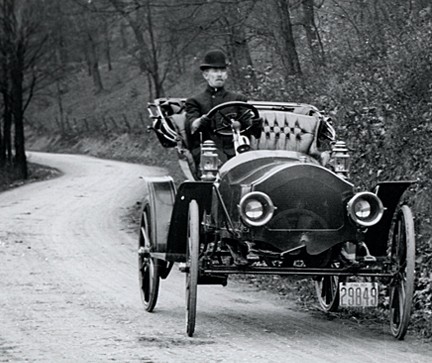This segment features a news item from Fayette County’s past. This week we examine a story from the February 9, 1924 edition of the Morning Herald.
The headline isn’t all that eye-catching: “Annual Meeting of Motor Club Monday Evening.” This was a reference to the Uniontown Motor Club, a relatively new group reorganized from the Automobile Club of Fayette County in May of 1923. Back then they only had 82 members, but over the ensuing year, more than 700 people joined. Clearly something interesting was going on here!
Now, when I think of motor clubs — as I sometimes do, being a fan of classic autos — I think of car cruises, roaring engines, and gleaming chrome. But while I’m sure many of the members loved showing off their cars, the Uniontown Motor Club of 1924 had a larger mission: making Fayette County’s roads safer for all drivers.

A local man takes a drive in the mountains. Credit: Uniontown Public Library.
A number of the club’s services were legal in nature. As mentioned in the article:
“[The Motor Club] supplies copies of local, state and national motor laws and regulations . . . It acts promptly in cases of illegal arrests of its members, fighting just as valiantly to protect its members from petty office holders as it does to see that strict attention is paid by all to existing traffic rules . . .”
The Motor Club (a partner of the Pennsylvania Motor Federation and the American Automobile Association) also provided travel services that are familiar to drivers today, including trip planning, route advice, and complimentary road maps. Not to mention that the annual dues of $6 — around $80 in today’s money — included “a handsome colored metal radiator emblem.” Nifty!
While the majority of the club’s services supported its members, there were certainly benefits for the general public. The group erected “large and legible” directional signs at five major entryways to Uniontown and intended to add more signs in the coming year. They also gave advice to out-of-towners on how to navigate Route 40’s tricky path to the Summit. Citing the mountain’s “nation-wide reputation for danger and difficulty,” they sometimes even offered to drive tourists’ cars over the Summit for them.
The group was a notable advocate for better road conditions in the county. For example, the Motor Club was one of several organizations to call for the improvement of Smithfield’s “Mile of Misery,” a particularly nasty strip of road that was fixed by the state and reopened in September of 1924. Anybody who is familiar with “pothole season” in Pennsylvania can certainly appreciate that.

Advertisement for the Uniontown Motor Club in the Morning Herald. May 31, 1923.







